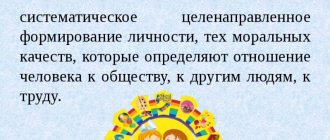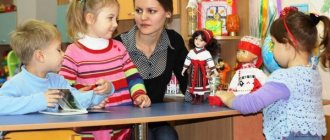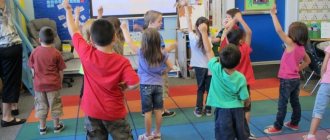Directions of moral development of a younger preschooler
In early preschool age, the development of the body’s mental processes occurs. The child’s capabilities expand: he can independently perform various household operations and master self-service skills. In addition, his social contacts are expanding: the child enters a preschool educational institution, where he interacts with new adults, as well as a group of peers. This requires focusing on developing the foundations of social interaction and establishing positive contacts.
Are you an expert in this subject area? We invite you to become the author of the Directory Working Conditions
The moral development of a younger preschooler is implemented in the following areas:
- Formation of elementary moral ideas. They affect the basics of behavior, its norms, ideas about good and evil, good and bad, right and wrong. The teacher introduces children to different situations and the behavior of their participants, analyzing their moral meaning and significance.
- Formation of the foundations of a culture of behavior. It requires mastering the rules of etiquette, showing politeness and tolerance towards other people. Here, the basics of cultural behavior in everyday life, in play and other activities of the child are mastered.
- Development of the basics of independent activity. They are necessary for the formation of one’s own views and beliefs, and the development of a worldview. Independence develops in everything: from self-service to the performance of various educational and work tasks.
- Formation of moral interaction with adults. Children are taught to respect their elders, listen to them, follow their instructions, and be polite. It is explained to children that an adult requires the child to do something for his own good, and not because he is an authority and does not take into account the child’s opinion.
- Active development of the sensual side of the personality. Children are taught to show their feelings and express them adequately. Emerging feelings and emotions must be manifested in real action. Otherwise, their development is pointless.
- Giving a humanistic orientation to the behavior of a preschooler. There is learning to establish positive social contacts, the formation of the habit of performing actions according to moral principles, the skills of moral interaction with the outside world and their predominance in any area of activity are developed.
Finished works on a similar topic
Course work Moral education of children of primary preschool age 470 ₽ Abstract Moral education of children of primary preschool age 220 ₽ Test work Moral education of children of primary preschool age 190 ₽
Receive completed work or specialist advice on your educational project Find out the cost
Features of moral development of young children
At an early age, children begin the process of moral personal development, which
- cognitive (information) aspect – knowledge and ideas about moral concepts, standards, norms, rules, personal moral qualities;
- emotional and motivational aspect - moral feelings, social and moral emotions, moral motives and preferences, moral assessment and self-esteem;
- behavioral aspect - moral actions and deeds, moral habits, i.e. implementation of moral norms and requirements.
The interrelation of cognitive, affective and behavioral components in the personal sphere determines the unity of moral consciousness and behavior . These components only begin to form at an early age. This is facilitated by children’s desire to collaborate with adults and their high imitation.
In early childhood, the child begins to understand certain moral rules of behavior . Such an understanding is limited to a specific situation, the framework of the child’s visual and effective thinking. Understanding the rules and norms of behavior is based on the child’s own experience, when he realizes the negative consequences of breaking the rules and the positive consequences of following them. In this regard, from an early age, an adult must justify the demands put forward, based on specific life situations and the child’s own experience. In children's active vocabulary there are few words denoting moral categories; evaluation and ethical concepts are used: good - bad, good - evil, etc. The concepts “bad” and “good” initially express the attitude of an adult, and the child only remembers and repeats them in similar situations . The content of motivational orientation from the standpoint of moral education is still poorly developed.
The development of the emotional component of a child’s morality is associated with the formation of intelligence, his mental activity, and a system of knowledge about encouraged and condemned patterns of behavior. Through this, the child gradually has the opportunity to evaluate his behavior and prepare to perceive the upcoming assessment of his activities by adults. A child’s moral emotions are manifested and strengthened in the process of observing specific actions and deeds of a person. For the moral development of a child, an organic connection between knowledge (moral concepts) and moral assessments of behavior (good - bad) is necessary. The formation of only knowledge about the moral qualities of people cannot ensure the emergence of corresponding moral feelings and emotions in a child; they appear in him as an expression of his own attitude to a certain human act, based on existing needs, a set of knowledge and experiences. The role of an adult in the moral development of children is that he teaches the child to evaluate actions and evokes in him an appropriate emotional attitude towards what is currently happening in a particular situation. Fixed in the child’s mind, such assessments begin to express his positive or negative attitude towards himself and the actions of others.
The increasing complexity of a child’s activities and his increasing independence lead to the need to introduce more complex moral rules of behavior. By obeying these rules, the child learns to regulate his actions. Compliance with moral norms and rules is not of independent importance for children, but is a means of maintaining positive contacts with adults and receiving a positive assessment from adults. The need for a positive assessment from an adult encourages the child to act in accordance with the rules.
Early age corresponds The stages corresponding to the premoral level are:
- obedience of a child to avoid punishment;
- the conditioning of actions by selfish considerations of mutual benefit (obedience in exchange for receiving some specific benefits and rewards);
- the conditioning of actions by the desire for approval from “significant others” and shame before their condemnation.
This does not mean that the child, under the influence of these motivating factors, systematically controls his behavior. It is very difficult for young children to resist immediately gratifying a momentary desire and even more difficult to perform an unattractive action at the suggestion of an adult. When performing uninteresting tasks for an adult, children either change them or get distracted and do not complete the task.
The formation of moral habits and actions is formed gradually; if an adult consciously puts forward systematic, consistent and motivated requirements, checks their implementation, then the implementation of such rules becomes habitual for the child. The child quickly reacts to the usual rules. Gradually, discipline, organization, and the need to follow the rules are formed, which contributes to the assimilation of more complex rules of behavior and the formation of moral qualities of the individual. The formation of moral habits in early childhood occurs in everyday activities, when an adult shows a model of behavior and requires the child to follow this model, first in joint activities with him, and then in independent activities.
Case Study
Maxim M., 2 years 8 months. His mother tries to ensure that her son sees manifestations of compassion and care among family members towards each other. “Don’t make noise, dad is tired, he’s sleeping. Don’t wake up dad,” mom says in a whisper. Maxim, imitating her, begins to behave quietly and, if one of the adults accidentally forgets, he himself will remind: “Nezya, daddy is drinking.”
In general, a young child is characterized by spontaneous morality. The child performs positive actions at the request of an adult and most often does not identify them as such. Without control and evaluation from an adult, the child acts situationally and impulsively, and therefore often breaks the rules. The moral behavior of young children is closely related to a positive emotional attitude towards the object at which it is directed. A child is more likely to do a good deed towards an adult or child whom he treats well. A positive emotional state, sympathy and goodwill towards other people and animals are the basis for moral manifestations.
Thus, the moral development of a young child occurs on the basis of presenting a system of demands to adults and teaching them to fulfill them. This is facilitated by children’s desire to establish and maintain positive contacts with adults. Based on imitation of adults’ assessments, the first value judgments are formed, which are then transformed into the child’s own attitude towards himself and other people. However, situational and impulsive behavior often leads to violation of requirements and prohibitions. The moral manifestations of a child depend on the emotional attitude towards an object and arise spontaneously, unconsciously, when prompted by an adult or in a specific situation.
Imitability as the basis for the moral development of a younger preschooler
The education of morality in three-year-old children is carried out on the basis of the principle of imitation. It means an active demonstration by adults - teachers and parents - of their own moral behavior in various situations.
Children of primary preschool age are distinguished by their responsiveness and sensory perception of adult behavior. They use imitation of him as the basis for building their line of behavior with others and their attitude towards the world around them.
The moral education of preschoolers, based on their imitation, is implemented through the observance by the teacher and other adults nearby of the following rules of behavior:
- Creating conditions for the formation of a child’s positive emotional state in different situations.
- Showing responsiveness towards the child: in response to suggestions and requests, expressing opinions and needs, showing empathy and mercy.
- Praise the child for various achievements and good deeds.
- Adults’ approval of the child’s display of kindness towards others: assistance, tolerance, respect.
- Negative attitude towards rudeness, aggression, greed of children. An adult needs to express his attitude in adequate forms: to show grief, frustration from such behavior of the child.
- Assisting the child in solving various problems.
- Show respect for the child's individuality.
- Providing assistance in resolving various conflict situations between children.
- Polite relationships with children, teachers, parents.
- Showing joy when another person succeeds or achieves something.
When to start developing the moral qualities of a person
There is an opinion that a person’s character is formed before the age of 5 - the rest of the time it can only be adjusted. Yes, the foundation of personality is laid in early childhood, but under the influence of the immediate environment, a person’s moral qualities can undergo changes throughout his life. Another statement: how well a child is raised depends on his future fate, the opportunity to find his place in life, and the ability to become happy.
By the age of 5, a child, as a rule, is already able to evaluate his actions, separate good behavior from bad, and control his emotions.
A child will not be able to develop the necessary moral qualities and behavioral skills without the direct participation of significant adults in this process. That is, the child must be taught all this, just like counting or tying shoelaces. The closest people to preschool children, as a rule, are parents and teachers.
Spiritual and moral education of preschool children - Teplova A.B. / Educators of Russia
MAGAZINE Preschooler.RF
Spiritual and moral education of children of primary preschool age through theatrical activities.Prepared by: teacher of MADOU “Kindergarten 28” Victoria Vyacheslavovna Malova
“The theater is a magical world. He gives lessons in beauty, morality and ethics. And the richer it is, the more successful the development of the spiritual world is..."
B.M. Teplov
Relevance:
In our daily lives, we are increasingly faced with the problem of the deterioration of the spiritual and moral state of society. Many families prefer watching cartoons with soulless characters. Children play "Monsters" , "Monsters" . The question arises: how can our children learn kindness, affection, and mercy from these heroes? To solve this problem, I chose to introduce children to theatrical play, since I believe that theatrical activities develop the emotional sphere of the child, make him sympathize with the characters and empathize with the events being played out.
Based on this, the goal arises:
To develop and nurture the spirituality in the soul of every child, to develop creative abilities, psychological emancipation of children through theatrical activities.
To achieve the goal, the following tasks are determined:
- Encourage children's interest in Russian folk tales.
- To develop in children the ability to correctly evaluate the actions of characters in puppet and dramatic performances, as well as to correctly evaluate their own and others’ actions;
- To form an idea of good and evil, to show the beauty of good deeds and their necessity in people’s lives.
- To form ideas about honesty, justice, kindness, to cultivate a negative attitude towards cruelty, cunning, cowardice;
All assigned tasks are implemented in the joint activities of educators and parents using a variety of forms and methods of work.
The group has created conditions conducive to the spiritual and moral education of preschool children through theatrical activities:
- A subject-development environment has been created, with a theater area equipped with: various types of theaters, props for performing skits and performances, a set of dolls, a screen for a puppet theater, elements of costumes, masks;
- Special texts were selected;
- Problem situations with accessible moral content underlying theatrical games are modeled;
Classes for children are held systematically twice a month in the afternoon, children get acquainted with various forms of theatrical games (tabletop toy theater, plane theater, puppet theater, dramatization games).
Theatrical games help create a joyful, relaxed atmosphere in the group. Children enjoy immersing themselves in the world of puppet theater. Behind the screen, they easily transform into fairy-tale characters. In my work, I often use theater in independent play activities, imitation games, games with theatrical puppets (glove, table, finger, etc.), exercises for working out basic emotions, breathing, articulation, finger gymnastics, development exercises facial expressions, gestures and movements, dramatization games. To dramatize fairy tales, I use voice imitation exercises, for example: Hare, Wolf, Bear, Fox, Kolobok.
Taking into account children's interest in fairy tales, their accessibility to children's perception, as well as the significance of fairy tales for the moral and aesthetic education of children, I use the most popular of them. For example:
the fairy tale “Teremok” teaches how to be friends; and the fairy tale “Turnip” develops in children the ability to be hardworking. The fairy tale “Masha and the Bear” warns that you should not go into the forest alone - you can get into trouble, and if this happens, do not despair, try to find a way out of a difficult situation. “Zayushkina’s Hut” is a fairy tale about a brave cockerel who helped a weak hare. The cowardly animals did not help the bunny, only the brave cockerel drove the fox away.
Fairy tales teach you to obey your parents and elders. In folk tales, hard work is always rewarded, wisdom is praised, caring for loved ones is encouraged.
In my work, I conduct conversations with children on the topics: “The magic word works wonders” , “What is kindness” . Conversations based on actions, fairy-tale literary characters, after reading works, theatrical performances. She used such fairy tales as “Two Greedy Little Bears” ; literary works by L. Voronkov “Masha is confused” , V. Mayakovsky “What is good, what is bad?” , D. Mamin-Sibiryak “The Tale of the Brave Hare” , etc. To consolidate the knowledge of fairy tales, didactic games based on familiar fairy tales were used: “Which fairy tale is the hero from” , the printed board game “Cut Pictures” . I made a lapbook “My Favorite Fairy Tales” , the content of which included several didactic games on this topic, a finger theater ( “Ryaba Hen” , “Kolobok” , “Teremok” , “Turnip” , “Zayushkina’s Hut” , “Cat, Rooster” and the fox" ), theater on sticks "Rukavichka" .
I use all appropriate cases in everyday communication and play to train children in the varied intonation of the most familiar words: “H-hello!” (joyfully, affably, benevolently, carelessly, gloomily); “Goodbye” (with regret, grief, hope to see you soon); “Give” (confidently, politely, patiently, with a desire to please), etc.
Music helps very well to convey the character's character. For example, with a familiar melody I encourage children to imitate the movements of various characters. After listening to the song, I use musical riddles: “Show how the bunny jumps” “Show how the bear walks” ; “Show me how high the frog jumps . While the children are completing the task, we, together with the rest of the children, watch and note the features of each “actor’s” , involving the children in finding their own ways of showing. In the future, we will definitely include fragments of this kind in theatrical games and then find practical use for them. For example, playing outdoor games led by fairy-tale characters, such as a bear, “Bear a Bear in the Forest ,” a wolf, “Geese and Swans . little goat “We lead, we lead a round dance...” .
It should be noted the importance of involving parents, since by encouraging curiosity, imparting knowledge to children, involving them in various types of activities, parents thereby contribute to the expansion of children's experience and the spiritual and moral education of children. Previously, I carried out the work by preparing consultations “Joint forms of work between kindergartens and parents on the formation of moral qualities” , “Theatrical activities in kindergarten” . I also prepared instructions for parents “Etiquette for Kids” , “Rules of Conduct When Visiting” ; consultations “How to cultivate politeness in children” , “Theater in a child’s life” , “Education with a fairy tale” . In our preschool institution, exhibitions “My Favorite Fairy-tale Hero” and “Baby Book” (on the theme “My Favorite Fairy Tale” ) were organized; parents happily took part. “Maslenitsa” was also organized . At the parent meeting, much attention was paid to family reading, and the parents also staged the fairy tale “Turnip” . We will continue to work in this direction, actively including parents in educational activities on spiritual and moral upbringing.
I would like to note that as a result of the work I carried out in the second junior group. The children have grown noticeably morally. They have become more attentive to those around them, notice the mood of other people, and the children’s vocabulary has significantly enriched. If earlier, to talk about a hero, children used the words: “bad - good,” now in their everyday life you can hear the following words: . ”
Thanks to theatrical activities, the moral qualities of preschoolers are formed, helping children to comprehend them not only with their minds, but also with their hearts, to pass them through their souls, and to make the right moral choice. There is an understanding of moral values, an increase in the moral culture of both students, teachers and parents; which helps strengthen cooperation between the preschool educational institution and the family.
Literature:
“Education of moral feelings in older preschoolers ,” edited by A.M. Vinogradova", M.: "Enlightenment" , 1989
Zaporozhets A.V. “Education of emotions and feelings in a preschooler // Emotional development of a preschooler, M: “Prosveshchenie” , 1985
Chistyakova M.I. “Psycho-gymnastics” , edited by Buyanov M.I., M.: “Enlightenment: VLADOS” , 1995
Rodina M.I., Burenina A.I. “Puppetry” , educational and methodological manual on theatrical activities, St. Petersburg: “Musical Palette” , 2008
Internet resources:
Aksyonova A.I. “Innovative activities of MDOU” , Novokubanks, 2011 based on materials from the site http: //nsportal. ru/site/27409/innovatsionnaya-deyatelnost-v—mdobu
Fomina M.V. Antipina S.V. Program for spiritual and moral education “Lessons of moral life” Tyumen, 2002, based on materials from the site https://ru. znatock. com/docs/index-5762. html
Telegin M.V. “Fundamentals of spiritual and moral education of children in preschool educational institutions” (program for advanced training of education workers) based on materials from the site http: //www. mtelegin. ru/pedagogika/duhovnonravvosp
| Next > |
How to cultivate spiritual and moral qualities, examples and recommendations
Personal example
It is known that the best method of education is personal example. Any words lose their meaning if they are not used in practice. No matter how much parents and educators talk about good behavior, respect for others and a humane attitude towards nature, if adults do not do what they talk about, then all the talk will be in vain.
For example, if dad declares that one must love animals, but he kicks away a stray kitten, then this is unlikely to be a worthy example to follow. If a mother communicates with her neighbor in the most kind way, but gives unflattering assessments behind her back, then her daughter is more likely to learn a lesson in hypocrisy and double-mindedness than a sincere attitude towards loved ones.
Moral education of preschoolers is not an easy task, and in order for your child to grow up to be a worthy person, he must copy your appropriate behavior.
Ability to share
It is extremely difficult for small children to understand why he should give, even temporarily, his favorite toy to a boy in the sandbox. The child still has no idea what generosity is, what greed is, and you shouldn’t reprimand him for it. You need to simply and unobtrusively tell how great it is when you can please another person - then you yourself will be happier, how great it is when you love not only receiving gifts, but also giving them.
A little later, the topic of “know how to share” can be expanded. Children learn that they can share not only objects, toys, and treats, but also a warm attitude, a good mood, and a smile. It is appropriate to recall the wonderful song about a smile from the cartoon.
Caring for others
It is also easier and more effective to cultivate such moral qualities as kindness and responsiveness through personal example. When children see that mom and dad love not only them, but also a disabled neighbor on the playground, that they are not capable of offending not only a person, but any living creature either by word or action, you can be sure that the kids will absorb into themselves this behavior.
At an early age, the spiritual and moral education of children through fairy tales is of invaluable importance. In particular, K.D.’s fairy tales vividly teach us to take care of others. Ushinsky “Know how to wait”, Russian folk song about a cockerel, a chicken and a bean seed, etc.
We learn the main ethical standards of a kindergartener
When already preparing your child for his first visit to kindergarten, you can teach a small but clear lesson on the topic “moral education of preschool children.”
It is possible that the child will have to face the fact that other guys are fighting.
- We need to explain to him that it is absolutely forbidden to offend other people, and especially beat them.
This first “no” leads to the second, which indirectly continues the first:
- You cannot spoil, tear, or break books or toys. They were made by people. Human labor was spent on them. By spoiling a thing, you will offend a person and disrespect his work.
- The little man must remember the third “no” for the rest of his life: taking someone else’s property without permission is theft.
These three “don’ts” ultimately turn into an undeniable truth: you cannot grow up to be a good person if you violate them.




